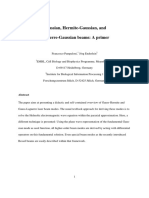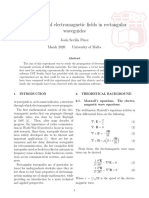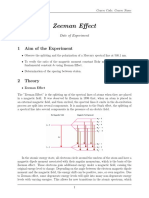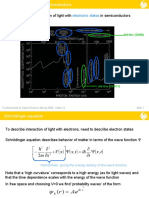5.3.2 Isotype Junctions, Modulation Doping, and Quantum Effects
5.3.2 Isotype Junctions, Modulation Doping, and Quantum Effects
Uploaded by
prashantsheetalCopyright:
Available Formats
5.3.2 Isotype Junctions, Modulation Doping, and Quantum Effects
5.3.2 Isotype Junctions, Modulation Doping, and Quantum Effects
Uploaded by
prashantsheetalOriginal Description:
Original Title
Copyright
Available Formats
Share this document
Did you find this document useful?
Is this content inappropriate?
Copyright:
Available Formats
5.3.2 Isotype Junctions, Modulation Doping, and Quantum Effects
5.3.2 Isotype Junctions, Modulation Doping, and Quantum Effects
Uploaded by
prashantsheetalCopyright:
Available Formats
5.3.
2 Isotype Junctions, Modulation Doping, and Quantum Effects
Isotype Junctions
Let's look at the band diagrams of an isotype heterojunction in equilibrium; we chose a somewhat extreme case:
Electrons were transferred form the (heavily n-doped) wide-gap material 1 to the (lightly n-doped; almost intrinsic)
small gap material 2. Space charge regions form; on the left hand side by positively charged ionized dopant atoms;
on the right hand side by the increased electron density.
In other words: In the low gap semiconductor we have carrier accumulation like in Si MOS devices.
What happens if we apply a bias U?
Well, draw the band diagrams. Move one side up by e · U, and make sure that the band discontinuities do not
change. What you get for the structure from above is shown below.
The current is always carried by majority carriers (electrons in our case). Inspecting the (exaggerated) drawings, it is
clear that this is relatively easy from left to right, but not from right to left. Without going into the details of the
characteristics, there are several novel features emerging with possible uses for devices. The first one of these effects is
clear; the following ones need consideration:
1. We may use an isotype heterojunction to inject majority carriers from the wide band gap material into the small
band gap material as in the case of diode-type junction.
2. We may use an isotype heterojunction to spatially separate the carriers generated by doping in the wide band
gap material from the doped region.
3. We might have peculiar new quantum effects.
While the first point is relatively clear, including its usability for light emitting devices (again, try to figure this out
yourself), the second and third point need some explaining.
Semiconductors - Script - Page 1
Modulation Doping
Let's look at the isotype junction in equilibrium again to understand the second point.
What happened is essentially that the electrons missing in the space charge region on the left hand side were
transferred to the potential dip on the right hand side. Of course, electrons are also running down the slope from the
right, but the essential contribution is from the wide band gap material on the left (which, after all, is the cause for
the dip).
Since we picked a highly doped material 1 and a lightly doped material 2, we now have a lot of electrons (their
density is essentially given by the doping in material 1) in a crystal with few ionized dopant atoms.
And what this means is that we now have a high density of highly mobile electrons, because the mobility at high
doping density is always severely decreased by scattering at the ionized dopants – cf. the paragraph to this topic.
This effect is most pronounced at low temperatures and can lead to a mobility enhancement of an order of
magnitude or even more.
This is not only generally useful, but can be carried to extremes. All we have to do is to make sandwiches as shown
below.
With properly chosen dimensions, deep potential wells will form in the low band gap material that contain most of
the electrons from the highly doped wide band gap material. This amounts to a novel way of effectively doping
material 2, called modulation doping.
If the potential wells are small enough (which is usually the case), the confinement of the electrons in the wells leads to
pronounced quantum effects – we therefore call these potential wells "quantum wells" (QW) and distinguish single
quantum wells (SQW) and multiple quantum wells (MQW).
An SQW is obtained by sandwiching just one small gap semiconductor, a MQW as shown above. The introductory
picture of the heterojunction subchapter showed examples of both types.
We may even improve on that by inserting an extremely thin layer (say 10 nm) of intrinsic material of a suitable
band gap between the two basic materials. If properly done, this layer, while not impeding carrier flow into the
potential wells for equilibration, keeps the carriers from being scattered at the interface and thus increases the
mobility even more.
But with that we have not yet exhausted the possibilities of heterojunctions – we will now turn to special quantum
effects.
Quantum Confinement Effects
Let's consider the peculiar quantum effects in modulation doped structures by looking at some typical dimensions.
The width of the various space charge layers must still be given by formulas not too different from the ones we had
for Si. For a GaAlAs/GaAs system with a high doping around 1018 cm–3 in the wide band gap GaAlAs side, the
width of the dips with the high electron density on the GaAs side is about 5 ... 10 nm, while the lateral extension is
large by comparison.
The mean free path length of the (highly mobile) electrons is larger than the thickness of the potential dip (better
called potential well for the multi-junction configuration shown above) and this means that we now have essentially a
two-dimensional electron gas.
What does that mean? Especially if we make the thickness of the layers extremely thin?
It means that we have a periodic crystal in two dimensions (x and y) and a one-dimensional potential well in the z-
direction, which is always the direction used in the pictures above.
The relevant Schrödinger equation is easy to write down, especially in the free electron approximation with a
constant potential (= 0) in x- and y-, and a potential V(z) in z-direction:
2 ∂2 ∂2 ∂2
1 1 1
– · + · + · ψ(r) – e · V(z) · ψ(r) = E · ψ(r)
2 mx* ∂x2 m y* ∂y2 mz* ∂z
2
This equation is solved by
Semiconductors - Script - Page 2
ψ(r) = ψvert(z) · ψlateral(x,y)
The two functions ψlateral(x,y) and ψvert(z) are decoupled, the solutions can be obtained separately. For the lateral
part we simple have
Solutions of the two-dimensional
ψlateral(x,y) =
free electron gas problem
The vertical part of the solution comes frome solving the remaining one-dimensional Schrödinger equation
2 ∂2
– · – e · V(z) ψvert(z) = Evert · ψvert(z)
2m z * ∂z2
It is rather clear that the structure of the two-dimensional problem will not be much different from that of the common
three dimenional problem if we introduce a periodic potential in (x,y). We simply obtain Bloch waves in two dimensions
instead of plane waves for ψlateral(x,y). The energy eigenvalues are unchanged, too, they were for the free electron gas
(using the effective masses by now).
2k2
lat
Elateral =
2m *lat
The solution of the one-dimensional problem in z-direction depends of course on the precise shape of V(z), but as a
general feature of potential wells we must expect a sequence of discrete energy levels. For the most simple case of
a rectangular well (with infinite height), standard calculations show that
( π)2 j2
Evert = ·
2m z * dz 2
With j = 1, 2, 3, ... = quantum number, and dz = thickness of the potential well.
The total energy of an electron is now given by
Etotal = Elat + Evert
( klat)2 ( π)2 j2
Etotal = + ·
2m *lat 2m *z dz 2
This "simply" means that the states in the conduction bands are now a discrete series given by the quantum
number j with a density of states per level of
· m *lat
Dlat = = constant
2π
If you like to try your hand at a little math: The formula for Dlat is rather easy to obtain if you follow the recipe for the
three-dimensional DOS for this case.
What do we get from this? Well, a lot of special effects for enthusiastic solid state physicists, but also some (not
necessarily big) advantages for devices. However.....
Each quantum well layer is now something like a one-dimensional atom – in contrast to the three-dimensional real
atoms were the wave functions of the electrons were confined in all three directions. If we move these "atoms" close
together in the z-direction, there must be a point where the wavefunctions in z-direction (the ψvert(z)) start to
overlap and do all the things real atoms do at close distance.
Semiconductors - Script - Page 3
The energy levels change and split, and – in analogy to a crystal formed by real atoms – a one-dimensional energy
band may start to develop with an energy range that is given by the geometry of the system, i.e., the thickness of
the layers, for a multi quantum well structure.
This is a momentous statement! Think about it!
It means that we can make materials with energetic properties that we can tailor at will (within bonds and limits, of
course). We no longer must just live with bandgaps and other properties that mother nature provides, we now can make
our own systems. At least in principle.
Something like that we call a metamaterial.
Multiple and single quantum wells are already part of recent devices as shown in the last subchapter.
Semiconductors - Script - Page 4
You might also like
- Nitrogen PowerpointDocument24 pagesNitrogen PowerpointArnis JapinsNo ratings yet
- Selected Solutions - David A.B. Miller Quantum MechanicsDocument53 pagesSelected Solutions - David A.B. Miller Quantum MechanicsRamzan8850100% (1)
- An Active Integrated Ultra-Wideband MIMO Antenna: Ieee Transactions On Antennas and Propagation 1Document6 pagesAn Active Integrated Ultra-Wideband MIMO Antenna: Ieee Transactions On Antennas and Propagation 1Asad RahmanNo ratings yet
- Dielectric WaveguideDocument9 pagesDielectric Waveguide曾令睿No ratings yet
- Lastec 421d PartsDocument145 pagesLastec 421d PartsCharles WernerNo ratings yet
- Lecture Notes Solid State Physics 1Document28 pagesLecture Notes Solid State Physics 1SOURAV KUMAR PATELNo ratings yet
- Homework 2Document2 pagesHomework 2ombraga1896No ratings yet
- Energy Bands and Charge CarriersDocument70 pagesEnergy Bands and Charge CarriersKOKONo ratings yet
- Surface Electromagnetic Waves at Gradual Interfaces Between Lossy MediaDocument10 pagesSurface Electromagnetic Waves at Gradual Interfaces Between Lossy MediaZainNo ratings yet
- II. Electronic Transport in Mesoscopic SystemsDocument41 pagesII. Electronic Transport in Mesoscopic SystemsMartinaNo ratings yet
- ReportDocument16 pagesReportElias KhouryNo ratings yet
- The Standard Model of Particle Physics: 2.1 Survey of Fundamental Particles and Their InteractionsDocument15 pagesThe Standard Model of Particle Physics: 2.1 Survey of Fundamental Particles and Their InteractionsLuis MNo ratings yet
- Propagation in Dielectric RectangulDocument14 pagesPropagation in Dielectric RectangulSalah LaibNo ratings yet
- Lecture Notes Solid State Physics 2Document15 pagesLecture Notes Solid State Physics 2SOURAV KUMAR PATELNo ratings yet
- Gaussian, Hermite-Gaussian, and Laguerre-Gaussian Beams: A PrimerDocument29 pagesGaussian, Hermite-Gaussian, and Laguerre-Gaussian Beams: A PrimerAl MohandisNo ratings yet
- Chapter 6: The Fermi Liquid: L.D. Landau December 22, 2000Document55 pagesChapter 6: The Fermi Liquid: L.D. Landau December 22, 2000padma princessNo ratings yet
- HiggsLectureNote PDFDocument49 pagesHiggsLectureNote PDFSelene Lysis M. VenturaNo ratings yet
- ReportElectromagnetism Jesus Sevilla PHY3111Document17 pagesReportElectromagnetism Jesus Sevilla PHY3111Jesús Sevilla PérezNo ratings yet
- Waves in Media: Ashcroft and Mermin, Solid State Physics (Saunders College, 1976, Page 553)Document42 pagesWaves in Media: Ashcroft and Mermin, Solid State Physics (Saunders College, 1976, Page 553)Amina lbrahimNo ratings yet
- Hitoshi QFTDocument18 pagesHitoshi QFTgemunu271No ratings yet
- I R ResponseDocument5 pagesI R ResponseRicardo Villagómez TamezNo ratings yet
- Part 5: Cavities and Waveguides: PHYS370 - Advanced ElectromagnetismDocument36 pagesPart 5: Cavities and Waveguides: PHYS370 - Advanced ElectromagnetismSaikat Ch BakshiNo ratings yet
- Calculation of The Changes in The Absorption and Refractive Index For Intersubband Optical Transitions in A Quantum BoxDocument8 pagesCalculation of The Changes in The Absorption and Refractive Index For Intersubband Optical Transitions in A Quantum BoxWilliam RodriguezNo ratings yet
- Transmission Coefficient of An Electron Through A Heterostructure With Nanometer-Thick Trapezoidal Barrier Grown On An Anisotropic MaterialDocument10 pagesTransmission Coefficient of An Electron Through A Heterostructure With Nanometer-Thick Trapezoidal Barrier Grown On An Anisotropic MaterialWIKEWIRANDANo ratings yet
- KP Theory of SemiconductorsDocument13 pagesKP Theory of SemiconductorstransfinitumNo ratings yet
- Folha 2 (5.)Document7 pagesFolha 2 (5.)Joao FernandesNo ratings yet
- Zeeman Effect: 1 Aim of The ExperimentDocument6 pagesZeeman Effect: 1 Aim of The ExperimentAmlandeep NayakNo ratings yet
- Density of States - DerivationDocument5 pagesDensity of States - DerivationsarathsrnairNo ratings yet
- No of Energy StatesDocument5 pagesNo of Energy Statesrahul lagisettiNo ratings yet
- Density of States Derivation: Electron WavefunctionDocument5 pagesDensity of States Derivation: Electron WavefunctionSiddharth GautamNo ratings yet
- Density of States - Derivation PDFDocument5 pagesDensity of States - Derivation PDFsarathsrnairNo ratings yet
- Electron-Phonon Interaction: 2.1 Phonons and Lattice DynamicsDocument14 pagesElectron-Phonon Interaction: 2.1 Phonons and Lattice DynamicsYeong Gyu KimNo ratings yet
- Moulton Catenoid in E-Field Revised2Document20 pagesMoulton Catenoid in E-Field Revised2HARDIKNo ratings yet
- The Space-Time Metric Outside A Pulsating ChargedDocument8 pagesThe Space-Time Metric Outside A Pulsating ChargedSenki AlphonsNo ratings yet
- Solutions To Selected Problems For Quantum Mechanics For Scientists and EngineersDocument53 pagesSolutions To Selected Problems For Quantum Mechanics For Scientists and EngineersOmran HagheghNo ratings yet
- Ij I I I I: 2 Jacob Lewis BourjailyDocument2 pagesIj I I I I: 2 Jacob Lewis BourjailySaul Perez BNo ratings yet
- Integrated Optical WaveguidesDocument14 pagesIntegrated Optical WaveguidesPhillip DoNo ratings yet
- One Dimensional Finite CrystalDocument11 pagesOne Dimensional Finite CrystalBayanjargal ErdeneeNo ratings yet
- Physical Chemistry Study GuideDocument9 pagesPhysical Chemistry Study Guidekrymxen100% (2)
- Notes 11 28Document3 pagesNotes 11 28Helia KamalNo ratings yet
- Exam 1 & AnswersDocument4 pagesExam 1 & AnswerspsychoxboyNo ratings yet
- OSE5312 Slides Class 12 - Optical Properties of Semiconductors 1Document22 pagesOSE5312 Slides Class 12 - Optical Properties of Semiconductors 1Mastering Zinc OxideNo ratings yet
- IsingDocument17 pagesIsingSyarifatul UlfaNo ratings yet
- Ghoussoub - 27 11 05Document34 pagesGhoussoub - 27 11 05Iulia IuliaNo ratings yet
- Review Persistent Spin HelicesDocument11 pagesReview Persistent Spin HelicesMarcAlomarPayerasNo ratings yet
- A Microscopic Model of Resonant Double-Barrier Tunneling in A Quantum SystemDocument25 pagesA Microscopic Model of Resonant Double-Barrier Tunneling in A Quantum SystemIbnu SholehanNo ratings yet
- Three PDFDocument46 pagesThree PDFAritro PaulNo ratings yet
- 2.57 Nano-To-Macro Transport Processes Fall 2004: Ikn A IkxDocument7 pages2.57 Nano-To-Macro Transport Processes Fall 2004: Ikn A IkxcaptainhassNo ratings yet
- 2D Plasmon Propagation Inside A Two-Dimensional Electron Gas Layer With A Low Loss Metallic GateDocument2 pages2D Plasmon Propagation Inside A Two-Dimensional Electron Gas Layer With A Low Loss Metallic GatersrinivasavaradanNo ratings yet
- Reiche 2001 0124Document3 pagesReiche 2001 0124Particle Beam Physics LabNo ratings yet
- Particle in A 1d Box Quantum MechanicsDocument22 pagesParticle in A 1d Box Quantum Mechanicsvivek patel0% (1)
- Ems ch9 NTDocument19 pagesEms ch9 NTPurna YalamanchiliNo ratings yet
- PHYS430: Advanced Lab Laith Marzouka ID: Dr. Khaled Eid: Topic: Conductance QuantizationDocument8 pagesPHYS430: Advanced Lab Laith Marzouka ID: Dr. Khaled Eid: Topic: Conductance QuantizationLaith MarzoukaNo ratings yet
- Rohini 14147559957Document10 pagesRohini 14147559957Midhun MNo ratings yet
- Chapter 5Document11 pagesChapter 5Muhammad FarhanNo ratings yet
- Lectuer Non Linear OpticsDocument22 pagesLectuer Non Linear OpticsOri CarmiNo ratings yet
- Chem3322 Notes1Document13 pagesChem3322 Notes1Priya RajanNo ratings yet
- Quantum ConfinementDocument60 pagesQuantum ConfinementSaeed AzarNo ratings yet
- Feynman Lectures Simplified 2C: Electromagnetism: in Relativity & in Dense MatterFrom EverandFeynman Lectures Simplified 2C: Electromagnetism: in Relativity & in Dense MatterNo ratings yet
- Cosmology in (2 + 1) -Dimensions, Cyclic Models, and Deformations of M2,1. (AM-121), Volume 121From EverandCosmology in (2 + 1) -Dimensions, Cyclic Models, and Deformations of M2,1. (AM-121), Volume 121No ratings yet
- Green's Function Estimates for Lattice Schrödinger Operators and ApplicationsFrom EverandGreen's Function Estimates for Lattice Schrödinger Operators and ApplicationsNo ratings yet
- Problems in Quantum Mechanics: Third EditionFrom EverandProblems in Quantum Mechanics: Third EditionRating: 3 out of 5 stars3/5 (2)
- Feynman Lectures Simplified 2B: Magnetism & ElectrodynamicsFrom EverandFeynman Lectures Simplified 2B: Magnetism & ElectrodynamicsNo ratings yet
- 44895371M PDFDocument376 pages44895371M PDFFrancisco CaballeroNo ratings yet
- Psych Rome TryDocument13 pagesPsych Rome TryAmira BagumbaranNo ratings yet
- Applications of Additive Manufacturing in The Marine IndustryDocument6 pagesApplications of Additive Manufacturing in The Marine IndustryJeeva RathnamNo ratings yet
- H630 01 Paper Dec 17Document8 pagesH630 01 Paper Dec 17Karman BattuNo ratings yet
- Problem Set For Quiz 1Document32 pagesProblem Set For Quiz 1Kyle TimonNo ratings yet
- LV Lead Sheathed CablesDocument60 pagesLV Lead Sheathed Cablesmegamaster2010No ratings yet
- CL - 5 Maths Combined PDFDocument19 pagesCL - 5 Maths Combined PDFTechno Gaming OfficialNo ratings yet
- Usace / Navfac / Afcec / Nasa UFGS-23 64 26 (August 2009) Change 6 - 11/22 - Preparing Activity: NAVFAC Superseding UFGS-23 64 26 (April 2008)Document54 pagesUsace / Navfac / Afcec / Nasa UFGS-23 64 26 (August 2009) Change 6 - 11/22 - Preparing Activity: NAVFAC Superseding UFGS-23 64 26 (April 2008)Ramon De los ReyesNo ratings yet
- AstroCel I - Prod - Mark - Broch - AFP 1 110BDocument4 pagesAstroCel I - Prod - Mark - Broch - AFP 1 110Bjonathan Reano MendozaNo ratings yet
- PlantUML Language Reference Guide enDocument174 pagesPlantUML Language Reference Guide endavidNo ratings yet
- Proposal BinodDocument16 pagesProposal BinodbinuNo ratings yet
- 7 Times Table Maths Mastery MatDocument2 pages7 Times Table Maths Mastery MatPooja MaldikarNo ratings yet
- FS 4Document92 pagesFS 4nissi guingab87% (15)
- 1 s2.0 S0360544223005960 MainDocument14 pages1 s2.0 S0360544223005960 MainFrank Joel Herrera ApaesteguiNo ratings yet
- 2021-11-06 23.45.15 CrashDocument5 pages2021-11-06 23.45.15 CrashIslam EleziNo ratings yet
- Unit Iii MCQDocument9 pagesUnit Iii MCQANKUR CHOUDHARYNo ratings yet
- TA500 Ignition System Analyser Operation ManualDocument9 pagesTA500 Ignition System Analyser Operation ManualKarlitosmanNo ratings yet
- Humboldt Dissertation VorlageDocument5 pagesHumboldt Dissertation VorlageWriteMyPapersDiscountCodeCleveland100% (1)
- Facility Management System (FMS)Document14 pagesFacility Management System (FMS)Sarfraz LocusNo ratings yet
- Gear TrainDocument26 pagesGear TraingowthamarajNo ratings yet
- PDF Sample Problem1Document34 pagesPDF Sample Problem1ERVIN JAMES ABULOCNo ratings yet
- Catalog: Control Valves For Heating, Ventilation and Air-Conditioning SystemsDocument278 pagesCatalog: Control Valves For Heating, Ventilation and Air-Conditioning SystemsandreyNo ratings yet
- Ashish Joshi ResumeDocument2 pagesAshish Joshi Resumeashish joshiNo ratings yet
- Helicoflex: Spring Energized SealsDocument12 pagesHelicoflex: Spring Energized Seals_Asylum_No ratings yet
- If Steam Drum Under Vacuum Then What Will HappenDocument2 pagesIf Steam Drum Under Vacuum Then What Will HappenyogacruiseNo ratings yet
- Selling ConceptDocument6 pagesSelling ConceptDhurba Bahadur BkNo ratings yet
- Holiday Inn Express Paris - Velizy: Your Confirmation Number Is: 85701768Document3 pagesHoliday Inn Express Paris - Velizy: Your Confirmation Number Is: 85701768amal alruqi100% (1)

























































































